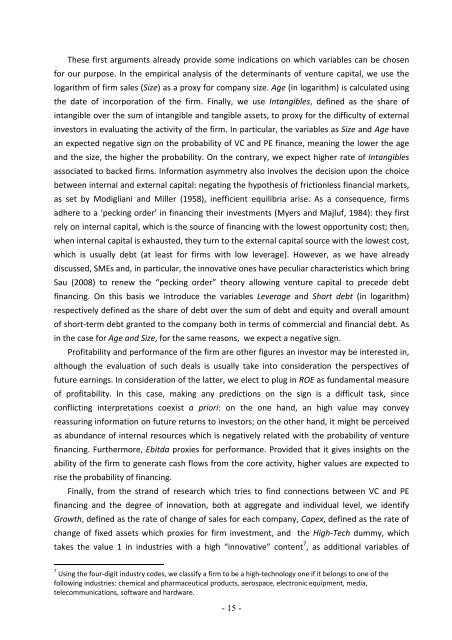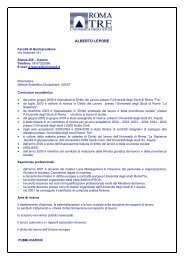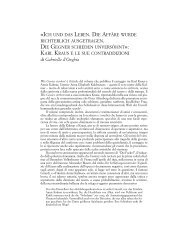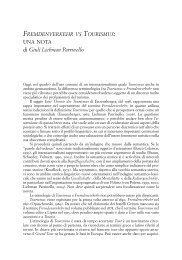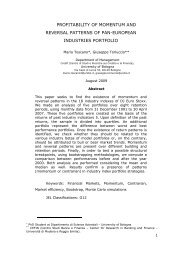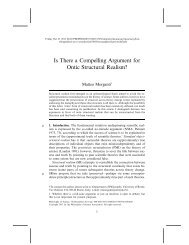Determinants and effects of Venture Capital and Private Equity ...
Determinants and effects of Venture Capital and Private Equity ...
Determinants and effects of Venture Capital and Private Equity ...
Create successful ePaper yourself
Turn your PDF publications into a flip-book with our unique Google optimized e-Paper software.
These first arguments already provide some indications on which variables can be chosen<br />
for our purpose. In the empirical analysis <strong>of</strong> the determinants <strong>of</strong> venture capital, we use the<br />
logarithm <strong>of</strong> firm sales (Size) as a proxy for company size. Age (in logarithm) is calculated using<br />
the date <strong>of</strong> incorporation <strong>of</strong> the firm. Finally, we use Intangibles, defined as the share <strong>of</strong><br />
intangible over the sum <strong>of</strong> intangible <strong>and</strong> tangible assets, to proxy for the difficulty <strong>of</strong> external<br />
investors in evaluating the activity <strong>of</strong> the firm. In particular, the variables as Size <strong>and</strong> Age have<br />
an expected negative sign on the probability <strong>of</strong> VC <strong>and</strong> PE finance, meaning the lower the age<br />
<strong>and</strong> the size, the higher the probability. On the contrary, we expect higher rate <strong>of</strong> Intangibles<br />
associated to backed firms. Information asymmetry also involves the decision upon the choice<br />
between internal <strong>and</strong> external capital: negating the hypothesis <strong>of</strong> frictionless financial markets,<br />
as set by Modigliani <strong>and</strong> Miller (1958), inefficient equilibria arise. As a consequence, firms<br />
adhere to a ‘pecking order’ in financing their investments (Myers <strong>and</strong> Majluf, 1984): they first<br />
rely on internal capital, which is the source <strong>of</strong> financing with the lowest opportunity cost; then,<br />
when internal capital is exhausted, they turn to the external capital source with the lowest cost,<br />
which is usually debt (at least for firms with low leverage). However, as we have already<br />
discussed, SMEs <strong>and</strong>, in particular, the innovative ones have peculiar characteristics which bring<br />
Sau (2008) to renew the “pecking order” theory allowing venture capital to precede debt<br />
financing. On this basis we introduce the variables Leverage <strong>and</strong> Short debt (in logarithm)<br />
respectively defined as the share <strong>of</strong> debt over the sum <strong>of</strong> debt <strong>and</strong> equity <strong>and</strong> overall amount<br />
<strong>of</strong> short‐term debt granted to the company both in terms <strong>of</strong> commercial <strong>and</strong> financial debt. As<br />
in the case for Age <strong>and</strong> Size, for the same reasons, we expect a negative sign.<br />
Pr<strong>of</strong>itability <strong>and</strong> performance <strong>of</strong> the firm are other figures an investor may be interested in,<br />
although the evaluation <strong>of</strong> such deals is usually take into consideration the perspectives <strong>of</strong><br />
future earnings. In consideration <strong>of</strong> the latter, we elect to plug in ROE as fundamental measure<br />
<strong>of</strong> pr<strong>of</strong>itability. In this case, making any predictions on the sign is a difficult task, since<br />
conflicting interpretations coexist a priori: on the one h<strong>and</strong>, an high value may convey<br />
reassuring information on future returns to investors; on the other h<strong>and</strong>, it might be perceived<br />
as abundance <strong>of</strong> internal resources which is negatively related with the probability <strong>of</strong> venture<br />
financing. Furthermore, Ebitda proxies for performance. Provided that it gives insights on the<br />
ability <strong>of</strong> the firm to generate cash flows from the core activity, higher values are expected to<br />
rise the probability <strong>of</strong> financing.<br />
Finally, from the str<strong>and</strong> <strong>of</strong> research which tries to find connections between VC <strong>and</strong> PE<br />
financing <strong>and</strong> the degree <strong>of</strong> innovation, both at aggregate <strong>and</strong> individual level, we identify<br />
Growth, defined as the rate <strong>of</strong> change <strong>of</strong> sales for each company, Capex, defined as the rate <strong>of</strong><br />
change <strong>of</strong> fixed assets which proxies for firm investment, <strong>and</strong> the High‐Tech dummy, which<br />
takes the value 1 in industries with a high “innovative” content 7 , as additional variables <strong>of</strong><br />
7 Using the four‐digit industry codes, we classify a firm to be a high‐technology one if it belongs to one <strong>of</strong> the<br />
following industries: chemical <strong>and</strong> pharmaceutical products, aerospace, electronic equipment, media,<br />
telecommunications, s<strong>of</strong>tware <strong>and</strong> hardware.<br />
- 15 -


